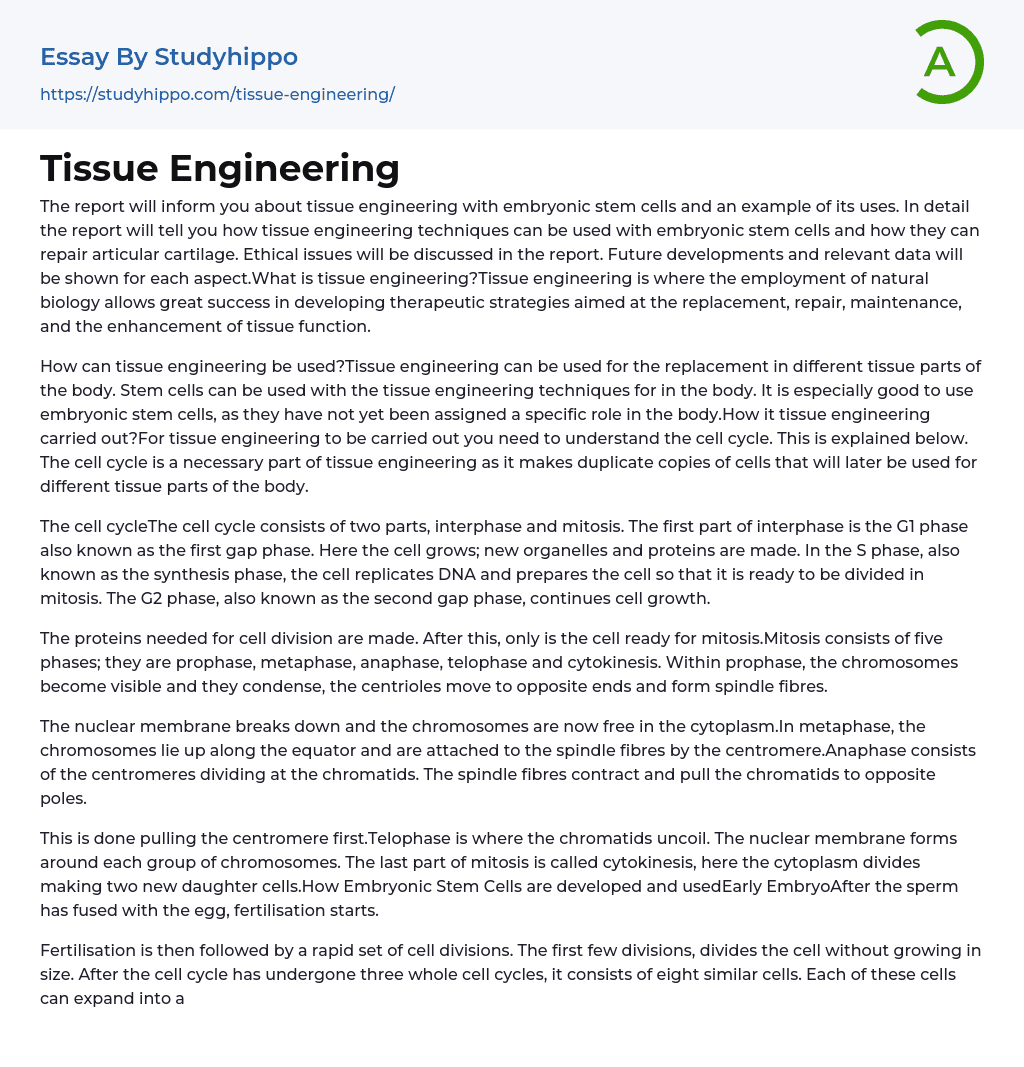This report will cover tissue engineering using embryonic stem cells, including an example of its application to repair articular cartilage. The report will examine the techniques involved in using embryonic stem cells for tissue engineering and address ethical considerations. It will also present relevant data and explore potential future developments for this field. Tissue engineering involves utilizing natural biological processes to develop therapeutic strategies that can replace, repair, maintain, and enhance tissue function.
Tissue engineering has different applications such as replacing tissue parts in the body. The technique involves using stem cells, with embryonic stem cells being particularly useful as they are not yet differentiated. Understanding the cell cycle is essential for the success of tissue engineering. The cycle produces duplicate cells that can be utilized in various tissue parts of the body.
The cell cycle inv
...olves interphase and mitosis. Interphase is split into three parts: the first gap phase (G1), synthesis phase (S), and the second gap phase (G2). During G1, the cell grows and creates new organelles and proteins. In the S phase, DNA is replicated in preparation for mitosis. Finally, during G2, the cell continues to grow.
Cell division requires the production of specific proteins before the onset of mitosis. Mitosis, comprising prophase, metaphase, anaphase, telophase and cytokinesis, occurs only after this preparation. In prophase, chromosomes become visible and undergo condensation, while centrioles move to opposite sides and develop spindle fibers.
The nuclear membrane disintegrates, releasing the chromosomes into the cytoplasm. During metaphase, the chromosomes align along the equator and connect to spindle fibers via the centromere. Anaphase involves the separation of the centromeres at the chromatids, as the spindle fibers contract and tu
the chromatids towards opposite poles.
The centromere is pulled first during mitosis, followed by chromatids uncoiling in telophase. The nuclear membrane forms around each group of chromosomes, and cytokinesis divides the cytoplasm to create two new daughter cells. In the early embryo, fertilization occurs when the sperm fuses with the egg, leading to the development and use of embryonic stem cells.
Following fertilisation, there is a swift succession of cell divisions. The initial divisions involve splitting the cell without any enlargement. Once the cell cycle has undergone three successive cycles, there will be eight similar cells. These cells are capable of expanding into a fully-developed, robust human being. Meanwhile, the blastocyst - which is a hollow bundle of cells - forms approximately five days after conception. As for the outer cell layer of the blastocyst, it proceeds to shape the placenta.
The inner blastocyst cell can develop into tissue in the early embryo and is called the pluripotent embryonic stem cell. Although these cells have the ability to become many cell types, they cannot form all 216 diverse cell types in the human body. The embryo can differentiate into specialized functions for the body as it develops. While some cells may lose their pluripotent abilities, most maintain the potential to develop into a range of cells.
The application of stem cells in medicine offers the potential to create human donor cells capable of generating new cells, tissues, or organs for transplant purposes. Embryonic stem cells offer a high probability due to their ability to differentiate into any cell type, providing great developmental flexibility. This is unlike older adult cells which can only serve a single function within the
body. Within a laboratory setting, the growth of embryos to form blastocysts is commonly accepted.
After some time, the embryo may undergo further refinement to investigate the possibility of stem cell production. The resulting stem cell is isolated from the rest of the embryo, which is ultimately discarded. Ideally, the stem cells will be nurtured and grow into transplantable tissues. However, utilizing stem cells in medicine poses challenges since the recipient's immune system may reject even properly introduced stem cells.
Transplant rejection is a well-known phenomenon with various methods available to prevent it. Among these methods, tissue typing is commonly used, which has been in practice for decades to identify a suitable blood transfusion donor. As for using multipotent stem cells copied from adults, there are no ethical concerns, a fact that is widely agreed upon.
There is concern that scientists may perceive the importance of stem cells for research and initial treatments to be less significant than pluripotent stem cells which can only be obtained from human embryos. Perspectives on the status of the human embryo vary, with some believing the use of any embryo for research is morally unethical, while others argue embryos require no moral attention. Some accept the embryo's potential as a human being and suggest respect should increase as it develops, although this respect may be weighed against potential research benefits. These views were addressed by the UK government committee set up to report on human stem cell research, as detailed in the SNAB Biology book.
- Administration essays
- Architect essays
- Discipline essays
- Doctor essays
- Engineer essays
- Farmer essays
- Hunter essays
- Labor essays
- Model essays
- Nurse essays
- Pilot essays
- Police Officer essays
- Professionalism essays
- Social Work essays
- Stakeholders essays
- Teamwork essays
- John Locke essays
- 9/11 essays
- A Good Teacher essays
- A Healthy Diet essays
- A Modest Proposal essays
- A&P essays
- Academic Achievement essays
- Achievement essays
- Achieving goals essays
- Admission essays
- Advantages And Disadvantages Of Internet essays
- Alcoholic drinks essays
- Ammonia essays
- Analytical essays
- Ancient Olympic Games essays
- APA essays
- Arabian Peninsula essays
- Argument essays
- Argumentative essays
- Art essays
- Atlantic Ocean essays
- Auto-ethnography essays
- Autobiography essays
- Ballad essays
- Batman essays
- Binge Eating essays
- Black Power Movement essays
- Blogger essays
- Body Mass Index essays
- Book I Want a Wife essays
- Boycott essays
- Breastfeeding essays
- Bulimia Nervosa essays
- Business essays




